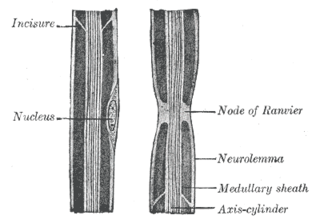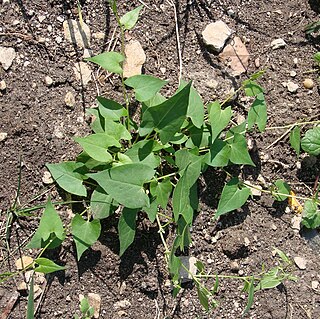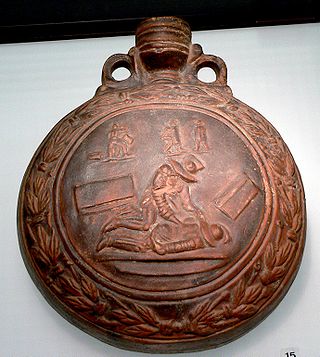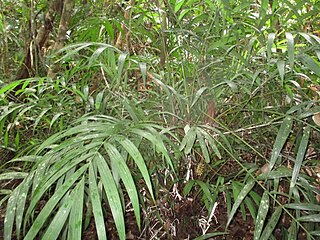
Neurilemma is the outermost nucleated cytoplasmic layer of Schwann cells that surrounds the axon of the neuron. It forms the outermost layer of the nerve fiber in the peripheral nervous system.

C4 carbon fixation or the Hatch–Slack pathway is one of three known photosynthetic processes of carbon fixation in plants. It owes the names to the 1960s discovery by Marshall Davidson Hatch and Charles Roger Slack that some plants, when supplied with 14CO2, incorporate the 14C label into four-carbon molecules first.

Fallopia convolvulus, the black-bindweed or wild buckwheat, is a fast-growing annual flowering plant in the family Polygonaceae native throughout Europe, Asia and northern Africa.

The murmillo was a type of gladiator during the Roman Imperial age. The murmillo-class gladiator was adopted in the early Imperial period to replace the earlier Gallus, named after the warriors of Gaul. As the Gauls inhabiting Italy had become well integrated with the Romans by the time of the reign of Augustus, it became undesirable to portray them as enemy outsiders; the Gallus-class gladiator thus had to be retired.

Emballonuridae is a family of microbats, many of which are referred to as sac-winged or sheath-tailed bats. They are widely distributed in tropical and subtropical regions around the world. The earliest fossil records are from the Eocene.

Rumex obtusifolius, commonly known as bitter dock, broad-leaved dock, bluntleaf dock, dock leaf, dockens or butter dock, is a perennial plant in the family Polygonaceae. It is native to Europe, but is found on all temperate continents. It is a highly invasive species in some zones, resulting from its abundant seed dispersal, adaptability to reproduce, aggressive roots, ability to tolerate extreme climates, and hardiness.
A kosha, usually rendered "sheath", is a covering of the Atman, or Self according to Vedantic philosophy. There are five koshas, and they are often visualised as the layers of an onion in the subtle body. The Tvam ("Thou") padartha of the MahavakyaTat Tvam Asi is determined by the analysis of Panchakoshas that are not the atman. Panchakoshas are discussed in the Brahmanandavalli Chapter of Taittiriya Upanishad which is a part of the Taittiriya Samhita of the Krishna Yajur Veda and in which particular chapter is discussed ways and means to achieve Brahman. It gives a detailed description of the dimensions of human personality or the dimensions of the Self.

A sheath knife is a fixed-bladed knife that fits in a sheath of leather or other material such as nylon or kevlar. The sheath is used to protect the knife and act as a carrier. Most importantly, the sheath protects the person carrying the knife from potentially serious injuries that the sharp, unprotected blade could easily cause. To provide sufficient protection, sheaths made of soft materials, such as leather, often have reinforcements, inside or outside of the sheath, made of metal sheet or other suitable materials having sufficient strength.

The femoral sheath is a funnel-shaped downward extension of abdominal fascia within which the femoral artery and femoral vein pass between the abdomen and the thigh. The femoral sheath is subdivided by two vertical partitions to form three compartments ; the medial compartment is known as the femoral canal and contains lymphatic vessels and a lymph node, whereas the intermediate canal and the lateral canal accommodate the femoral vein and the femoral artery (respectively). Some neurovascular structures perforate the femoral sheath. Topographically, the femoral sheath is contained within in the femoral triangle.

Persicaria virginiana, also called jumpseed, Virginia knotweed or woodland knotweed is a North American species of smartweed within the buckwheat family. It is unusual as a shade-tolerant member of a mostly sun-loving genus. Jumpseed is a perennial, named for its seeds which can "jump" several feet when a ripe seedpod is disturbed.
Brown syndrome is a rare form of strabismus characterized by limited elevation of the affected eye. The disorder may be congenital, or acquired. Brown syndrome is caused by a malfunction of the superior oblique muscle, causing the eye to have difficulty moving up, particularly during adduction. Harold W. Brown first described the disorder in 1950 and initially named it the "superior oblique tendon sheath syndrome".

In fashion, a sheath dress is a fitted, straight cut dress, often nipped at the waistline with no waist seam. When constructing the dress, the bodice and skirt are joined together by combining the skirt darts into one dart: this aligns the skirt darts with the bodice waist dart. The dress emphasizes the waist as its skirt portion is fitted. While the sheath dress can come in many patterns and lengths, it often is worn with short sleeves and reaches knee length.
Plectocomiopsis is a dioecious genus of flowering plant in the palm family found in Indochina, Malaysia, Borneo and Sumatra. Hapaxanthic and armed with spines, they are a climbing rattan, closely related to the Myrialepis palms. The name is Greek for "similar to Plectocomia", another close relative.
Persicaria cespitosa, known as tufted knotweed, is a summer annual weedy plant of the family Polygonaceae, native to eastern Asia, from China to Japan and Southeast Asia, and introduced into North America. The plant grows to 3.5 feet (105 cm) in height with elliptic to lanceolate leaves, usually 20–75 mm long. It has small pink or red flowers arranged in tight terminal spikes.
Racquel Sheath is a retired New Zealand track and road cyclist. She represented her nation at the 2015 UCI Track Cycling World Championships.
The gens Luscia was a minor family at ancient Rome. Members of this gens are first mentioned in the early part of the second century BC. They were of senatorial rank, but few of them achieved the higher offices of the Roman state. The only known consul of this gens was Lucius Luscius Ocrea, during the Flavian dynasty.

Pinanga cattienensis is a species of small palm in the family Arecaceae. It is endemic to Vietnam, having been found in Cat Tien National Park in Đồng Nai Province, growing in seasonally-flooded tropical forest at low elevations.

Licuala cattienensis, is a small fan palm, endemic to southern Vietnam. The type locality is in Cát Tiên National Park in Đồng Nai Province, growing in seasonal tropical forest in flat areas near rivers at low elevations. It is recognisable by being much smaller (<2m) and single-stemmed, in comparison the larger L. spinosa, which is common in the Park and grows in grows in clumps.

Rumex britannica is a flowering plant species in the family Polygonaceae.(Buckwheat family) (perennial).
Calamus erectus, also known as viagra palm and locally as tynriew, tara, and zhi li sheng teng, is a flowering shrub in the family Arecaceae. The specific epithet (erectus) refers to the plant's habit of growing straight rather than creeping or climbing like many species of the genus Calamus.













